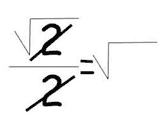6.62606 x 10-34 J*s
Enlightenment
Although very very small, Planck’s constant has some fantastic results. At the beginning of the 20th century, Maxwell Planck was looking at blackbody radiation, which is what happens when you heat a black object and it emits light, like the burner on your stove or the sun.
The Discovery!
He discovered that the light energy given off cannot take on any possible value it wants, but only a defined set of values. He came up with Planck’s constant as a way of relating the frequency of light emitted to the amount of energy in that light.
So, if we take the amount of radiated light energy and divide it by both Planck’s constant and the frequency, we get a whole number.
Light Packets
This finding later led Einstein to propose that light energy comes in little packets or particles called photons. This whole number that we get by dividing the light energy by the frequency and Planck’s constant is actually the number of photons that are emitted. This dramatically changed the way we think about light.
But light also acts like a wave, which was shown by the double slit experiment.
Dual Personality
So, light behaves both like a particle and a wave, appropriately called the wave-particle duality of light. Light has mass (an unbelievably small amount), but it also has an amplitude, frequency, and wavelength.




